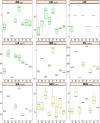Resequencing and phenotyping of the first highly inbred eggplant multiparent population reveal SmLBD13 as a key gene associated with root morphology
- PMID: 40809110
- PMCID: PMC12344552
- DOI: 10.1093/hr/uhaf167
Resequencing and phenotyping of the first highly inbred eggplant multiparent population reveal SmLBD13 as a key gene associated with root morphology
Abstract
The MEGGIC (Magic EGGplant InCanum) population here presented is the first highly inbred eggplant (Solanum melongena) multiparent advanced generation intercross (MAGIC) population developed so far, derived from seven cultivated accessions and one wild Solanum incanum from arid regions. The final 325 S5 lines were high-throughput genotyped using low-coverage whole-genome sequencing (lcWGS) at 3X, yielding 293 783 high-quality SNPs after stringent filtering. Principal component analysis (PCA) and neighbor-joining clustering revealed extensive genetic diversity driven by the unique genetic profile of the wild founder, and lack of genetic structure, suggesting a well-mixed population with a high degree of recombination. The eight founders and a core subset of 212 lines were phenotyped for above- and belowground traits, revealing wide phenotypic diversity. Root morphology traits displayed moderate heritability values, and strong correlation were found between root and aerial traits, suggesting that a well-developed root system supports greater aboveground growth. Genome-wide association studies (GWAS) identified a genomic region on chromosome 6 associated with root biomass (RB), total root length (RL), and root surface area (SA). Within this region, SmLBD13, an LOB-domain protein involved in lateral root development, was identified as a candidate gene. The S. incanum haplotype in this region was linked to reduced lateral root branching density, a trait that may enhance deeper soil exploration and resource uptake. These findings provide key insights into root genetics in eggplant, demonstrating MEGGIC potential for high-resolution trait mapping. Furthermore, they highlight the role of exotic wild germplasm in breeding more resilient cultivars and rootstocks with improved root architecture and enhanced nutrient uptake efficiency.
© The Author(s) 2025. Published by Oxford University Press on behalf of Nanjing Agricultural University.
Conflict of interest statement
The authors declare no conflicts of interest.
Figures





Similar articles
-
Benchmarking of low coverage sequencing workflows for precision genotyping in eggplant.BMC Plant Biol. 2025 Aug 25;25(1):1125. doi: 10.1186/s12870-025-07242-x. BMC Plant Biol. 2025. PMID: 40855264 Free PMC article.
-
Prescription of Controlled Substances: Benefits and Risks.2025 Jul 6. In: StatPearls [Internet]. Treasure Island (FL): StatPearls Publishing; 2025 Jan–. 2025 Jul 6. In: StatPearls [Internet]. Treasure Island (FL): StatPearls Publishing; 2025 Jan–. PMID: 30726003 Free Books & Documents.
-
Heritability estimates and genome-wide association study of methane emission traits in Nellore cattle.J Anim Sci. 2024 Jan 3;102:skae182. doi: 10.1093/jas/skae182. J Anim Sci. 2024. PMID: 38967061 Free PMC article.
-
Intravenous magnesium sulphate and sotalol for prevention of atrial fibrillation after coronary artery bypass surgery: a systematic review and economic evaluation.Health Technol Assess. 2008 Jun;12(28):iii-iv, ix-95. doi: 10.3310/hta12280. Health Technol Assess. 2008. PMID: 18547499
-
Home treatment for mental health problems: a systematic review.Health Technol Assess. 2001;5(15):1-139. doi: 10.3310/hta5150. Health Technol Assess. 2001. PMID: 11532236
Cited by
-
Benchmarking of low coverage sequencing workflows for precision genotyping in eggplant.BMC Plant Biol. 2025 Aug 25;25(1):1125. doi: 10.1186/s12870-025-07242-x. BMC Plant Biol. 2025. PMID: 40855264 Free PMC article.
References
-
- Yang Y, Tilman D, Jin Z. et al. Climate change exacerbates the environmental impacts of agriculture. Science. 2024;385:eadn3747. - PubMed
-
- Abbas M, Abid MA, Meng Z. et al. Integrating advancements in root phenotyping and genome-wide association studies to open the root genetics gateway. Physiol Plant. 2022;174:e13787. - PubMed
-
- Qaim M. Role of new plant breeding technologies for food security and sustainable agricultural development. Appl Econ Perspect Policy. 2020;42:129–50
-
- Maqbool S, Hassan MA, Xia X. et al. Root system architecture in cereals: progress, challenges and perspective. Plant J. 2022;110:23–42 - PubMed
-
- Den Herder G, Van Isterdael G, Beeckman T. et al. The roots of a new green revolution. Trends Plant Sci. 2010;15:600–7 - PubMed
LinkOut - more resources
Full Text Sources

